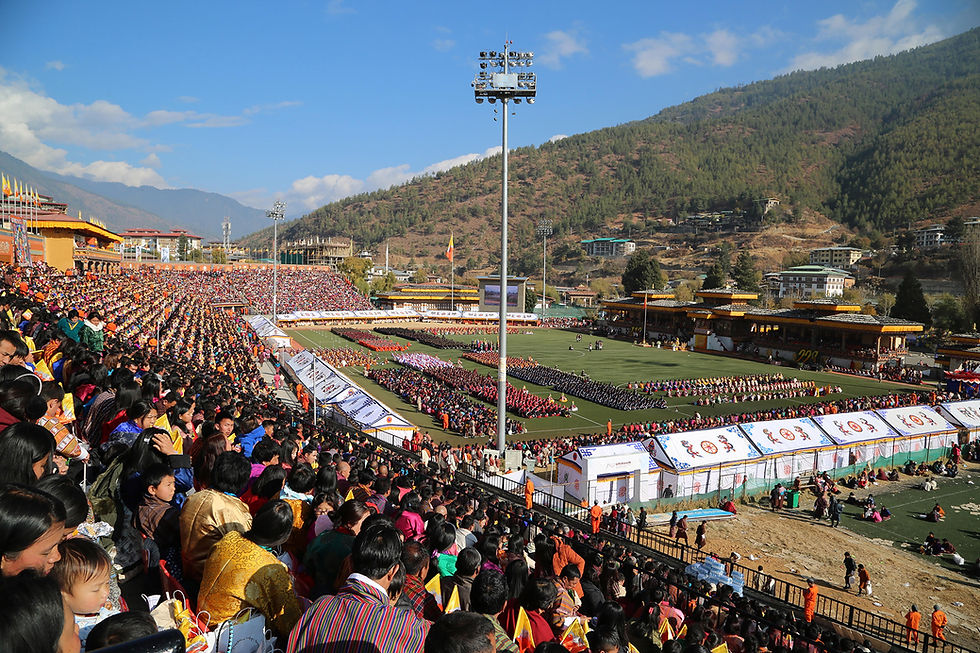The Black-necked Cranes of Bhutan
- Bhutan Himalaya

- Feb 23, 2018
- 4 min read
Updated: Feb 7, 2019
Rare and endangered, Black-necked Cranes are celebrated in Bhutan as the souls of virtuous monks who have returned to the world in an elegant form.
In Phobjikha, a high valley hidden among the folds of the Black Mountain Range, local residents believe this is why the cranes circle the valley's beautiful 13th century Gangtey monastery three times—in the traditional fashion of religious circumabulation—when they first arrive in the valley on their annual return migration from the Tibetan Plateau.
Over the centuries the Gangteps—as the local people are known after their beloved monastery—have evolved a set of complex beliefs that enable them to coexist peacefully with the cranes. The folklore includes stories that reinforce the belief that the arrival of healthy numbers of cranes each year from beyond the high Himalayas promises good harvests to come. A decrease in the number of returning cranes are seen as indications of a leaner year.
They are celebrated in song and dance and the national sport of archery where winning teams of shooters mimic the preening dance of the cranes, their hands akimbo like the outspread wings of the cranes.
The local legends even go so far as to say that the cranes have an inherent understanding of the traditional astrological calendar, intuiting their arrival in the valley and departure from Bhutan, in other words the timings of their annual migratory patterns, in accordance with the days and hours deemed favorable in the astrological charts. This particular bit of intelligence on the part of the cranes is especially endearing to most Bhutanese people who enjoy a passion for the national pastime of using astrological charts to secure advantageous timings for nearly every aspect of travel and (archery) competition.
Black-necked cranes or Grus nigricollis (as they are scientifically known) were first identified by the 19th century Russian explorer Nikolai Przhevalsky. Since then human encroachment into their habitats and environmental degradation of their roosting grounds have resulted in a dramatic decline in the Black-necked crane population. Today the estimated number of Black-necked cranes left is believed to be between 8,000 and 11,000. In the early 1990s their population in Bhutan was recorded at 1,743 individuals. The numbers dropped to 1,664 between 1996 and 2000.
Largely because of ongoing conservation efforts the numbers have gone back up to 2,352 cranes as recorded by Bhutan’s Royal Society for the Protection of Nature (RSPN).
While the cranes are also found in other valleys of central and eastern Bhutan, Phobjikha is the best place to see the cranes because much of the work to protect their habitat and provide environmentally sound ways of viewing them have been done in this valley.
Black-necked crane conservation in Bhutan began nearly four decades ago when His Late Majesty Jigme Dorji Wangchuck (Bhutan’s third monarch and grandfather of the current king) invited the well-known Indian ornithologist Dr. Salim Ali to the kingdom to research and write a book on the birds of Bhutan.
Dr. Ali's enthusiasm for the assignment was born of a longstanding personal quest to find the elusive Black-necked cranes. He was delighted when, traveling with the king in the Bomdeling region of eastern Bhutan, a feathery explosion of an estimated 300 Black-necked cranes filled the skies above their heads.
The conservation of Black-necked cranes in Bhutan received a huge boost when Dasho Paljor Dorji, known affectionately as “Benji,” established the Royal Society for the Protection of Nature (RSPN) which continues the work of Black-necked crane conservation today. Dasho Benji began monitoring Black-necked crane populations in Phobjikha, Bomdeling and other parts of Bhutan in 1984.
To highlight the plight of the Black-necked cranes and educate the public on their breeding and migratory habits, he helped produce and narrated the popular documentary On the Wings of a Prayer (the title of our trip is a nod to this seminal bit of conservation filming; for more on the trip, please visit the link to the trip page provided below).
Black-necked cranes, also sometimes known as the Tibetan Crane, grow up to be around 55 inches long, with a wingspan of up to 7.8 feet and up to 12 lbs in weight.
Full grown cranes sport bare red crowns and “lores” (the area between the eye and the bill) that are sparsely covered by black, hair-like feathers. The rest of the head and the upper part of the neck are black, except for a small white or light gray spot extending back from the rear and lower edges of each eye.
Usually the body is mostly ash gray, becoming almost white underbelly and elsewhere. The tail is black, and the upper tail coverts are grayish. The primary and secondary feathers are black. Its eyes are yellow, legs and toes are black. Males and females are virtually indistinguishable, although males tend to be slightly larger in size.
Juvenile birds usually have yellow-brown feathers on the crown, and a gray abdomen. Like the adults, their primary and secondary feathers are black but their back is grayish-yellow while black and white feathers alternate on the neck.
Graceful and elegant, the survival of the Black cranes is crucial to the culture of Bhutan where an annual festival celebrates their return each year from Tibet.
To see Bhutan's graceful Black-necked cranes and celebrate their return to the Phobjikha valley this year or in the early spring of 2019, please visit: On the Wings of a Prayer, a journey celebrating Bhutan's Rare Black Necked Cranes.
~







Comments